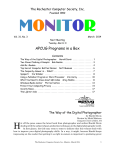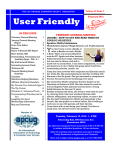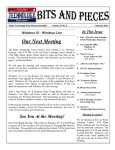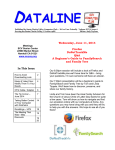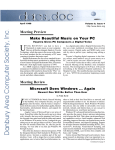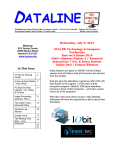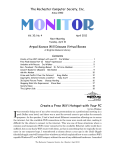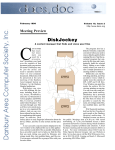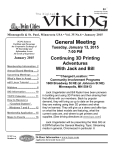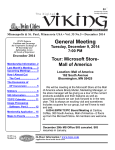Download Adobe - The Rochester Computer Society, Inc
Transcript
The Rochester Computer Society, Inc. a computer club for everyone Founded 1982 M ON I TOR Vol. 32, No. 3 March 2015 Next Meeting Tuesday, March 10 Additional Browser Tips with Mark Zinzow Contents Should You Back Up Everything Bob Rankin . . . . . . . . . . . . . . . Amazon Prime Streaming Media Takes on Netflix Ira Wilsker Ask Mr. Modem . . . . . . . . . . . . . . . . . . . . . . . . . . . . . . . . . . . . . . . . “Free Speech” on the Internet Diane Fahlbusch . . . . . . . . . . . . Imagine Processing Software Dick Maybach . . . . . . . . . . . . . . . Microsoft to Releasse Windows 10 FREE Ira Wilsker . . . . . . . GIZMO’s Freeware . . . . . . . . . . . . . . . . . . . . . . . . . . . . . . . . . . . . . Society News . . . . . . . . . . . . . . . . . . . . . . . . . . . . . . . . . . . . . . . . . . The Lighter Side . . . . . . . . . . . . . . . . . . . . . . . . . . . . . . . . . . . . . . . . . . . . . . . . . . . . . . . . . . . . . . . . . . . . . . . . . . . . . . . . . . . . . . . . . . . . . . . . . . . . . . . . . . 1 3 7 9 13 17 16 .16 17 Should You Back Up Everything? What Files and Data MUST Be Backed Up? by Bob Rankin askbob.com efore I begin, I want to share something that happened just this morning. The doorbell rang, the dog barked, and I could see the mailman waiting there, with two packages and a stack of letters. One in particular caught my attention. It was a handwritten letter from James, one of my AskBob readers. The final paragraph of his letter absolutely made my day: “I love what you are doing in B providing so much information about computers and internet... There is no one like you. You are an answer to the prayers of all of the computer-internet technology ignorant people like me. Thanks, and keep it up, please!” I hope you don’t mind me sharing that. I’ve been writing about computers and the Internet since 1994, answering questions, and as another reader put it, “translating for the technology impaired.” Feedback that like really inspires me to keep pressing on. The Rochester Computer Society, Inc. Monitor /March 2015 1 So let’s get down to business. One of the most common things I’ve heard from readers when discussing backups is confusion (or strong opinions) about what really needs to be backed up. Some say they occasionally copy their documents to a CD or flash drive. Others have a list of folders that they routinely back up to an external hard drive. A few mentioned that they use Google Drive or Dropbox to keep files or folders synced to online storage. Some prefer the simplicity of online backups with Mozy, Carbonite, or iDrive, which attempt to identify and back up your “important” files. Others make a clean distinction between “system files,” “program files,” and “user files.” Some create partitions on their hard drive to separate each type of data. They do backups for all files and folders that are created by them and the software they use. But they don’t back up the operating system and installed software, because it can be re-installed from CDs in the event of a hard drive crash. Theory and Practice In theory, there’s nothing wrong with any of those ideas. But in practice, it’s not the best approach, unless you’re a bit geeky and have lots of time on your hands. If your hard drive fails, you’ll need to re-install the operating system, apply any needed security patches and updates, reconfigure all your customizations and personal settings, then install all your programs. Locating the software installation media (CDs or downloaded files) and license keys for paid software can be a big hassle. Only then can you restore your user files from backup. That whole process can take many hours, often requires a bit of technical know-how, and you’re never quite sure that everything is put back the way it was. Quite often, people find that they forgot something. A critical file or folder is missing from the backup. A Better Way (and my success story)... By contrast, I recently had a hard drive go bad. It took me just 23 minutes to restore 60+ gigabytes of data, and I was back up and running like nothing happened. I was able to recover so quickly and easily because I do full system backups (also called “image backups”) every Sunday, and incremental backups every weekday at 3AM. An image backup rolls EVERYTHING on your hard drive into a single file that can be stored on a flash drive or external hard drive. It can be used to restore the entire drive, or just selected files and folders. All that happens automatically with my favorite free backup software, so I never have to worry about remembering to do it. There’s a chapter in my ebook with step-by-step instructions and screen grabs for doing exactly that. When my hard drive refused to boot up, and I couldn’t even detect a single file on it, I didn’t panic because I knew that every single file was safely backed up. As I mentioned in my last posting, CONFIDENCE beats HOPE every time! (I actually take my backups 2 or 3 steps further, but I’ll discuss my personal backup strategy in my posting next Monday.) To those who say “I don’t need to do backups” let me point out that I’ve had TWO instances in the past six months where a new hard drive went on the fritz, and it seemed like a total loss. Stuff happens ... hardware failure, viruses, power surges, data breaches, and natural disasters. Things can get lost, stolen, wet, or broken. And there’s always human error and those annoying “senior moments.” So YES! Everyone who uses a computer needs a backup. And ideally, you should backup everything, automatically, and often. Hard Drive, CHECK. What Else? Any backup is better than nothing, but hopefully I’ve convinced you that it’s a good idea to make full system (image) backups. Free software is available to make it a simple and automatic process. All you need is an inexpensive USB flash drive or an external hard drive. And in my book, you’ll learn about free online backup options. So that covers the hard drive on your desktop or laptop. Have you thought about the data on your mobile gadgets? If your phone was stolen, or went through the wash, just imagine losing your address book, photos, apps and text messages. And here’s something else to consider. More and more, our lives are moving online. What would you do if your email, your The Rochester Computer Society, Inc. Monitor /March 2015 2 Facebook account, or online files got hacked, wiped out, or your password was lost? Amazon Prime Streaming Media Takes on Netflix by Ira Wilsker s I type this, the extremely popular streaming media company Netflix is operating in over 40 countries, and has in excess of 50 million paid subscribers. Originally known for its mail based DVD rental service, Netflix is currently the world leader in streaming media subscriptions. Once thought of in monopoly terms, Netflix is now facing serious competition from a multitude of sources including the online retailer Overstock.com, retailing megalith WalMart, and the marketing powerhouse of Amazon. While the lesser streaming media competitors (if anyone could ever consider Walmart a “lesser competitor”) have barely dented Netflix dominance in the streaming media market, Amazon’s growth as a direct competitor has been explosive. According to Rich Tullo, the Director of Research for the old line Wall Street firm of Albert Fried & Company, “It looks to me like they are very close to or preparing to approach 45 million U.S. [and UK] subs by the end of 2015. They could be pretty close to it now.” ... I think they’re probably really close to Netflix in terms of U.S. subs.” According to Tullo, “ (Amazon) Prime subscribers are attracted to both the instant video content and the free two-day shipping, not one or the other. Once they see the platform, I think they like it,” Tullo said of those who accepted a trial offer. “I like it, it’s easy to use, and it’s got a full content offering. It’s very synergistic with their (Amazon’s) business.” While most readers of this column are at least somewhat familiar with Amazon’s Prime services, many are not probably aware of the breadth and depth of the Prime offerings currently available for a $99 annual membership. Subscription discounts are available to students with an “edu” email address, new mothers (Amazon is the largest seller of diapers in the US), Prime subscriptions given as a gift, new Prime subscribers may qualify for a discount, and Prime may be available as a free affinity benefit from some of the premium credit card companies. One-time free trials of Prime are also available from Amazon. While Netflix at about $8 per month predominately provides the benefits of “SVOD” (Streaming Video on Demand), Amazon provides somewhat competitive streaming media, as well as many additional benefits not available to Netflix subscribers. The list of Amazon Prime benefits are extensive and includes free two-day shipping on most items sold by Amazon; Prime Instant Video, which includes over 40,000 titles of unlimited streaming of movies and TV; Prime Music, which includes unlimited, ad-free access to hundreds of Prime Playlists and more than a million songs for members; Prime Photos, secure unlimited photo storage on the Amazon Cloud Drive; Prime Pantry where members can purchase low priced grocery, household, and pet care items for a flat delivery fee of $5.99 for each Prime Pantry box; Prime Early Access, where bargain hunters can get 30 minute early access to select Lightning Deals on Amazon; Kindle Owners’ Lending Library where Prime members can borrow for free many of the otherwise paid Kindle e-books; Kindle First, where members can download a new book for free every month from the Kindle First picks; Membership Sharing, where Prime members may invite up to four eligible household members living at the same address to enjoy the shipping benefits of a Prime membership at no extra cost. While the majority of Amazon Prime members apparently join to get the free two day shipping benefits, the other major reason why (according to Tullo) Amazon Prime has tripled its membership in the last couple of years is its rapidly expanding library of streaming media. According to Amazon, “Prime members can watch thousands of movies and TV shows at no additional cost. ... You can instantly stream Prime Instant Video titles from your computer’s web browser, Fire phone, Fire TV, Fire Tablets, iOS devices, Android phones, and hundreds of other Internet-connected TVs, Blu-ray players, set-top-boxes, and gaming consoles.” In addition to its paid Prime subscribers, Amazon also makes the streaming media available for free to those with a 30 day trial of Amazon Prime or Amazon Prime Instant Video. A The Rochester Computer Society, Inc. Monitor /March 2015 3 Amazon’s current collection of movies and TV shows is smaller than that of Netflix, but Amazon is constantly increasing its selection of available media, with the clear intent of going head to head with Netflix. Amazon also offers one of the largest collections of streaming music in the industry, with millions of titles available for free to subscribers. In addition to licensing content from the Hollywood movie houses and national and international TV networks, Amazon also had a massive collection of movies, shows, and series created by the pay-per-view and subscription media companies, such as HBO. Amazon, like Netflix, has started to finance the production of quality media and movies exclusively for its subscribers. According to a January 14 article published by MSN, “In Amazon, Netflix battle, consumer is the winner,” by Therese Poletti of Market Watch, “The video-streaming battle between Netflix and Amazon.com Inc. is intensifying, as both companies seek to become more like Hollywood producers, with Amazon upping the stakes this week in a big content deal. Amazon, fresh off two awards at the Golden Globes for its new show “Transparent,” announced a deal on Tuesday with filmmaker Woody Allen to write and direct his first television series.” In an article by the Motley Fool, dated January 31, “Amazon announced plans to launch a dozen original movies starting this year.” In addition to original movies, Amazon is also actively producing a large collection of new series, ten of which the pilots have been completed and are currently available to Amazon Prime and Prime Instant Video subscribers to view and evaluate. The ten recently released pilots, joining the stable of already released series, include several animated series for children (Buddy, Tech Detective; Sarah Solves It, and the Stinky and Dirty Show), a fully acted children’s series (Just Old Magic), and several comedy, action and drama series including The New Yorker Presents, Point of Honor, Man in the High Castle, Cocked, and Mad Dogs. Amazon Studios Vice President Roy Price is quoted on Amazon.com as saying, “Our first pilot season of 2015 brings some of the greatest storytellers in the business to Amazon customers with works of novelty and passion. We’re very excited by the shows and look forward to getting customers’ reactions.” I recently viewed “Cocked,” and found it totally entertaining and well done from an artistic view. Many other viewers of “Cocked” have had the same impression, as 1535 reviews of “Cocked” have been posted on Amazon, with 922 reviewers giving it 5 stars, and 352 giving it 4 stars, with the remaining 231 giving it lower scores, with an overall average of 4.3 out of 5 stars. I agree with the consensus of many of the reviewers who stated that “Cocked” included a good blend of both humor and drama. In terms of accessibility, the Amazon Prime streaming media, including the videos and the million-plus streaming music titles, are available on almost all internet connected devices, including computers, tablets, Amazon’s Fire devices Apple and Android powered devices, set top streaming media boxes and sticks, and gaming consoles. Personally, I have watched a reasonable selection of Amazon’s “SVOD” (Streaming Video on Demand) directly on my desktop computer browser (mostly Firefox), my Android smart phone, and on my primary flat screen TV. On my smart phone I use the basic Amazon app to access my prime account, and then click on the menu icon on the top left corner of the screen to select the desired media types, and then choose the specific music or videos that I want. Any movies or TV shows with the “Prime” logo across their top left corner are available to Prime subscribers for free, while some of the new releases under the “Shop” categories, without displaying the Prime logo, are available for sale or rental. On my primary flat screen TV, I use an inexpensive but powerful Amazon Fire TV Stick, which plugs directly into an available HDMI port, to access the extensive Prime libraries, as well as content from several other streaming services. In my experience, the extensive collection of over 40,000 free movies and TV shows, as well as over a million free music titles was totally adequate for my needs. While the streaming media and delivery services such as Netflix helped lead to the demise of much of the DVD rental industry, such as disappearance of Blockbuster, the current technology of widely available broadband internet along with the reasonably priced “SVOD” (Streaming Media on Demand) services, consumers have several good choices for digital entertainment. I have to agree with Therese Poletti, in her January 14 MSN story, “In The Rochester Computer Society, Inc. Monitor /March 2015 4 Amazon, Netflix battle, consumer is the winner.” We all benefit from competition between strong competitors. Watch for even more upcoming enhancements from Amazon and Netflix, as they battle with each other for market share. Just as Netflix appeared from nowhere and defeated Blockbuster, and Amazon is now taking on Netflix, do not count out the upstart competitive services from Walmart, Overstock.com, Hulu Plus, and other services. We really do live in interesting times. Websites: http://www.amazon.com/Cocked/dp/B00RSGI10U/ http://www.amazon.com/gp/help/customer/display.html?nodeId=200444160 h t t p : / / w w w . a m a z o n . c o m / P r i m e - I n s t a n t - V i d e o / b / r e f = s v _ a t v _ 0 ?_ e n co d i n g =UTF8&node=2676882011 http://www.msn.com/en-us/money/technology/in-amazon-netflix-battle-consumer-is-thewinner/ar-AA8aEhj http://finance.yahoo.com/news/analyst-says-amazon-prime-reach-185905585.html http://www.nasdaq.com/article/should-netflix-inc-and-amazoncom-be-making-movies-cm438851 http://www.marketwatch.com/story/netflix-is-the-favorite-in-streaming-market-2015-01-16 http://www.marketwatch.com/story/amazon-unveils-13-new-shows-2015-01-06 http://www.nasdaq.com/article/overstockcom-is-no-threat-to-netflix-or-amazoncom-cm438935 http://www.forbes.com/sites/dorothypomerantz/2015/01/22/netflix-and-amazon-will-have-aharder-time-with-movies-than-they-did-with-tv/ money.cnn.com/2015/01/11/media/amazon-netflix-golden-globes /index.html https://gma.yahoo.com/blogs/abc-blogs/amazon-amzn-movie-plans-shake-hollywood-154658496-abc-news-deals.html https://au.finance.yahoo.com/news/amazon-produce-acquire-original-movies-230111020.html https://en.wikipedia.org/wiki/Netflix https://en.wikipedia.org/wiki/Amazon.com#Amazon_Prime Investigate Slow Connection Q. I’m using high-speed Internet over a phone line. It works okay, but on occasion it goes so slow that most sites never finish downloading. Is this a provider problem? I would start your investigation with your Internet service provider, and initially determine what connection speed range you should have. Your provider’s Web site will have that information or you can call their Customer Service department. With that information in hand, run several speed tests using a site such as speedtest.net, bandwidthplace.com, or cnet.com/internet-speed-test. Connection speeds can vary greatly throughout the day and night, so conduct tests at varying times over several days. If your average upload and download speeds fall below what you should be receiving, contact your provider’s Tech Support. In that way you will have evidence to support your assertion that the connection speeds you are receiving are not what were represented and your provider can investigate from there. Q. I received a message from Yahoo! Mail telling me that I’m running out of storage space and that I need to provide my password so they can increase my capacity. You’ ve warned us about anybody that asks for our passwords, so I’ m suspicious. Is this for real or what? A. Your suspicion is justified. I’m glad you remembered what I so frequently yammer about: Never provide your password or voluntarily confirm any other personal or account information The Rochester Computer Society, Inc. Monitor /March 2015 5 when requested to do so by email. No legitimate organization or service will ever ask you for that information. Just delete the message you received and don’t give it another thought. Q. In my old version of Firefox I was able to bookmark a site to a folder. But now if I click the star, it doesn’t allow me to select a folder. I have to move it into a folder after the fact by opening all bookmarks. Is there an easier way? A. In the current Firefox, you can instantly create a bookmark by selecting the star icon at the top right of the browser. When the star turns blue, your bookmark is created, so tap or click the star again. (Medical Tip: When you turn blue, call 9-1-1.) You will see options to edit the bookmark. You can also drop it into an existing folder using the drop-down menu, or create a new folder. Q. When I installed the latest version of Microsoft Office on my Windows 8 computer, all my favorite keystroke combinations, such as ALT + F + V for Print Preview are gone. Now I have to use the mouse or touchpad, click in the corners, scroll here and there – it drives me crazy. Any suggestions, Mr. M? A. The good news is that most of your favorite keyboard commands are still present, but have been changed. Why? Because it would obviously make too much sense to leave them as they were. Your beloved Print Preview is now ALT + CTRL + I. Accessing a list of all keyboard commands is as simple as clicking the question mark in the upper right of the page. Word Help will open. Type “keyboard shortcut” and you will find a complete listing. I tested a bunch of them out under both Windows 7 and Windows 8 and didn’t run into any problems, so I think you will be very pleased with the results. Mr. Modem’s DME (Don’t Miss ‘ Em) Sites of the Month Ba Ba Dum Ba Ba Dum is a language game that lets you practice your vocabulary in one of eleven different languages, including my native Svenska. When you arrive at the site, click Play to begin and select the language you want to practice by clicking the country’s flag graphic. For a real challenge, you can practice in a randomized assortment of languages. In the top-right corner you will see your score. There are two numbers: Your cumulative score and the score for the language you are currently playing. This site presents a fun way to practice vocabulary in different languages. http://babadum.com Crossword Puzzles If you’re a crossword-puzzle enthusiast, this is an online treasure trove of puzzles. With a repository containing more than 32,000 crosswords, you are guaranteed endless hours of entertainment or escapism. www.crosswordpuzzlegames.com/ Pica Pic Created by Hipopotam, this site features a digitalized collection of handheld games. These games triggered a wave of nostalgia for me. I can still remember playing my Little Mermaid game on the school bus and almost being beaten to death. Good times, indeed. Use the menu at the bottom to select a game and use the arrows at the left and right of the screen to scroll back and forth. A down arrow shows which game is currently selected. If you mouse over the game, a Play button appears. If you want to play that game, click it to begin. This will enlarge the game and display its controls. The games feature the same sounds as if you were playing the original handheld version. www.pica-pic.com Use Promo Code MODEM when entering your six-month subscription to Mr. Modem’s award-winning weekly computer-help newsletter and receive one month for free! Visit www.MrModem.com. “Free Speech” on the Internet, and More by Diane Fahlbusch ICON PC User Group (ICONPCUG), Long Island, NY The Rochester Computer Society, Inc. Monitor /March 2015 6 ocial networking has allowed people to express themselves to either select people or to the public. Unfortunately, many posters do not exercise restraint, claiming it is their “right.” Freedom of Speech is a highly treasured right granted to Americans. However, it is also the most misunderstood and abused rights granted under the First Amendment to the Constitution of the United States. To quote it directly, “Congress shall make no law S respecting an establishment of religion, or prohibiting the free exercise thereof; or abridging the freedom of speech, or of the press, or the right of the people peaceably to assemble, and to petition the Government for a redress of grievances.” But does this give one the complete freedom to say whatever, whenever and however one wants? The original purpose of Freedom of Speech was to allow for religious freedom and different political views to be expressed. When the USSR started making some changes, it was jokingly phrased that citizens still had the same long lines to wait in, but were now allowed to complain about them. This is something Americans take for granted. The Constitution also allowed the press to publish verified facts and editorials without recrimination. (The key here is VERIFIED facts. The Watergate scandal was actually exposed to by two reporters, which then led to criminal investigations.) However, that does not give one carte blanche to say whatever one wants. This is evidenced by the existence of cease and desist orders, gag orders, restraining orders, retractions, and the like emanating from defamation and harassment cases. Defamation is defined as “the action of damaging the good reputation of someone,” and encompasses both slander and libel. Slander is SPOKEN defamation or false statements. Libel is “WRITTEN, PRINTED or PICTORIAL representation which unjustly damages an individual’s reputation, OR the act of presenting such a statement to the public.” Harassment is “disturbing or irritating persistently.” All of these actions may land one in court. The fastest growing concern in police departments is Cyber-bullying. Perhaps part of the problem is that the parents are really not supervising what their children are doing on. As one Suffolk County Police officer stated, “Would you just drop your kid off at Times Square at 10:00am and go back at 5:00pm to pick them up? Well, what do you think you’re doing when you hand them an I-Pad and never look at what they’re doing?” Additionally, there is a marked increase in pedophile crimes due to internet communications. Some recent evidence of statements being curtailed involves Twitter and Facebook postings. Some are blatant stupidity, as in the March 29th Facebook posting by Colleen Chudney that she did drink but did not get caught by the breathalyzer test by her parole officer. The 22-yearold was on probation for a 2012 drunk driving offense, and part of her parole was that she refrained from consuming any alcohol. Her parole officer saw the posting and called her. She hung up on him, which is another parole violation. He insisted on a urine test to check for drinking within the previous 80 hours. She was granted another 93 days in jail instead of her parole ending just a few weeks later. A recent case involved a man who posted a public message about his estranged wife on Facebook. On November 23, 2011 Mark Byron posted the hate filled rant. It sparked great debate on the online circles while the case was pending. Of course most of the commentators ignored the fact that a court order of protection had already been issued to his wife and son after he was convicted of civil domestic violence against her last year. On February 23, 2012, a judge ruled that he had to post a lengthy apology and corrections to his previous inaccuracies on his Facebook page for 30 days or face 60 days in prison and $500 fine. Musician Courtney Love’s 2010 public Twitter posting to reporter Alan Cross about an unnamed attorney who was “bought off” is another recent example. The attorney, Rhonda Holmes, brought a defamation case against Love. Surprisingly, the case was decided in Love’s favor on January 25, 2014, since the attorney was not named, the posting was quickly removed once Love realized she had marked it “public” instead of “private,” and, although the statement was false and injurious to Holmes’s reputation, the case itself restored that reputation. (Each state’s laws have nuances to them.) The Rochester Computer Society, Inc. Monitor /March 2015 7 However, Love had to pay $430,000 in damages when she was sued in 2011 over statements posted on Twitter and Myspace regarding fashion designer Dawn Simorangkir. There is currently another case still pending, brought by Simorangkir against Love, based on accusations of theft on the Howard Stern's radio show and “taunting” on the social media site Pinterest. The press has also become one of the greatest violators in the past few decades. They do not always verify their facts before reporting a story, and news stories are really editorials rather than reporting. The best example is the man accused of setting off a home-made pipe bomb at the Atlanta Olympics in 1996. Almost everyone remembers his name, Richard Jewell, because for 10 days the news stations kept flashing his picture and name and basically stating that he did it. Numerous newspapers also made the same claim. They could have chosen to say that this man was a key to the investigation. They also selectively exposed facts about his personal life to present an unsavory character. And even when he was cleared by the police a few weeks later, no one bothered to repeatedly show his picture and state that he was actually a hero. (He was a temporarily employed security guard making little more than minimum wage, yet he risked his life to help others.) And of course, most people cannot name the actual bomber. For the record, it was Eric Rudolf. He first became a suspect in 1998 and pleaded guilty in 2005 after eluding arrest for five years. As an immediate aftermath of this “Freedom of Speech,” Richard Jewell found that he was unemployable after all of the press coverage. Not only would potential employers rip up his resume and/or job application when they saw his name, but he was cursed at, thrown out of potential employers’ offices and sometimes had things thrown at him. Even strangers on the streets of Atlanta and other towns bombarded him with verbal and physical abuse (spitting, punching and kicking). He had no choice but to sue those who had maligned him. The NY Post, NBC, and CNN just settled quickly, although they maintained there was no wrongdoing. But Cox network, owners of a string of news stations and publication, took the case to court and dragged it through the appeals court. Sadly on both accounts, the case was dismissed in August, 2007 after Richard Jewell’s death because there was no plaintiff. However, law enforcement agencies reevaluated how, when and what information to release to the public to prevent what they now call “The Richard Jewell Syndrome.” Devices come with instruction manuals and warning labels. Unfortunately speech does not come with this message: WARNING - Engage brain before engaging mouth. People also seem to have lost their common sense and consideration. Why would you discuss your life publically on your social media page – or someone else’s? That is part of the problem with social media – very few think before they post. The other problem is that the postings can be marked either “public” or “private,” but most people do not pay attention to this. Furthermore, that private post you just sent can in turn be resent and made public by your “friend.” Another interesting point is that even emails that are sent across a public network (otherwise known as the The Rochester Computer Society, Inc. Monitor /March 2015 8 internet) are considered “public” messages, according to copyright law. So, no, one DOES NOT have the RIGHT to say whatever pops into one’s head – especially on social media, or any other media. And remember, the first four letters of Twitter spell “Twit.” Act responsibly and don’t be one! From the June 2014 issue of The ICONPCUG Graphic, newsletter of the ICON PC User Group, Long Island, NY. Courtesy of APCUG. Image Processing Software, Part 2 by Dick Maybach Brookdale Computer Users’ Group, NJ n the first article (February 2014 newsletter available at www.bcug.com) we discussed photo retouching using GIMP (GNU Image Processing Program). However, GIMP does not develop raw files; for that you need a program such as RawTherapee. Why would you want to bother with this extra step? In the picture inside a church, the frame on the left is the JPEG image as produced by my camera, while the one on the right is the same image, but I used RawTherapee to process it from a raw file. (I have my camera set up to save every picture as both a JPEG and a raw image and decide what processing to use after I see the results.) I This example shows one advantage of working with a raw images. In the JPEG, the roof is essentially black with no visible detail, while in the processed raw image, the details are visible. This is not a simple exposure compensation, as you can see by noting that the highlights in the two images (for example as seen through the open door on the right) have about the same brightness. While adjusting the brightness, I also compensated for the perspective distortion resulting from the wide-angle lens. As a result, the image on the right is much closer to what your eye would see. (The changes here are modest, in an attempt to keep the result realistic. You can easily go off the rails and produce results that belong in a comic strip.) The improvement is possible because the camera records 12 bits per pixel per color, while a JPEG image has only 8. In other words, the raw image has 16 times the dynamic The Rochester Computer Society, Inc. Monitor /March 2015 9 range of the JPEG one. In photo terms, this means that the raw image has two to three more f-stops of range that a corresponding JPEG. The screen-shot below shows an image being processed by RawTherapee (http://rawtherapee.com/ for Linux, OS X, and Windows). The panel on the right shows the tools availalbe, and these are grouped with tabs. The color adjustment tab has been selected and the white balance tool within it. From left to right the tabs are exposure, detail, color, transform, raw processing, and metadata. Histograms for luminance, and the three primary colors are visible at the top of this panel. The left panel shows the history of the changes, and the center one the current state of the image. If you look carefully, you will see a button on the bottom, just to the left of the orange "Ready" button. Clicking this develops the image and sends it to GIMP as a 16-bit TIFF file. (As I noted in the previous article, the current version of GIMP is capable of only 8-bit processing, so it immediately converts the file to 8-bit TIFF. Hopefully, this butchering will stop with the next version of GIMP.) The next button to the left outputs a JPEG, TIFF, or PNG file directly. I frequently skip GIMP altogether as RawTherapee can often do all the processing I need. RawTherapee is a non-destructive editor; that is, it makes no changes to the image file. Instead, it creates a separate script file that specifies the processing to be done when the raw image is developed. The processing occurs in the order the program deems optimal. As a result, the order in which you perform your editing is unimportant. This is much different than with a program such as GIMP, which changes the image directly in sync with what you do. In the latter case, the order of the editing steps is quite important. RawTherapee requires some persistence to master, partly because it has no help file. Expect to spend some time reading the manual and searching the Web for examples before you become comfortable with it. Finally, although it should run on a 32-bit operating system without difficulty, a 64-bit one is recommended. RawTherapee has a unique ability to correct for lens distortion. When your camera saves an image in raw format, the file includes a JPEG thumbnail in which the lens distortion has been corrected (providing that if your camera has a removable lens, it’s compatible with the camera). The program uses the thumbnail to correct any distortion in the raw image. All other programs that incorporate automatic distortion correction, including Photoshop, use databases, The Rochester Computer Society, Inc. Monitor /March 2015 10 and these don’t cover all combinations of cameras and lenses. Indeed, RawTherapee can use the same Adobe camera and lens profiles used by Photoshop, but it is a non-trivial process to adapt them. Lightzone (http://www.lightzoneproject.org/ for Linux, OS X, and Windows) is a raw developer with a much different approach. For one, you can specify only a portion of the image for a particular processing step, while RawTherapee always works on the entire image. It can also show you which portions of the image have similar luminosities, which is frequently helpful. The screen-shot below shows an image being edited in LightZone. In the right-hand panel, the icons below the thumbnail bring up windows, a new one each time you click on an icon. Each window is one application of an editing tool, which can apply to the whole image or just a portion. If you delete a window, the changes you made using that step are also discarded. When you develop the image, the processing is done in the same order as the tool windows, so unlike RawTherapee, their order can be important. You can reorder the processing by dragand-drop moving of the tool windows. You can also change the way in which the effects of each tool are combined in the final image. The left-hand panel shows the editing history. Here, I’ve adjusted the white balance, applied the relight tool (which lightened the shadows and darkened the highlights) and further lightened the shadows. Then I used the color selector to select the very bright areas (the window and the sun-lit highlights on the table) and reduced the luminosity of only those regions. Finally, I rotated the image. All this takes longer to describe than to do. The screen-shot shows a region selected based on its luminosity, but I could have based it on color, or just by drawing an outline. Like RAWTherapee, LightZone has several pre-defined styles, and often applying one of these is the only thing you need do to obtain a satisfactory result. Unlike RawTherapee and UFRaw, LightZone has no provisions for correcting distortions. (If you look carefully at the window frame and the bookcase, you can see some curvature, which results from my particular lens, a wide-range zoom. Better lenses have less distortion and some cameras correct for it in their raw images.) To get the best results from LightZone you must start from a raw image, as JPEG has discarded much of the photo’s dynamic range. Since the program can’t correct lens distortion, you would pass the developed image file to GIMP in TIFF format (to avoid degrading it with JPEG compression). There, you would correct he image in GIMP, perhaps by comparing it to a JPEG version of a photo as processed by your camera. The Rochester Computer Society, Inc. Monitor /March 2015 11 The combination of GIMP, RawTherapee, and LightZone will provide the tools to do almost all your image processing. I’ve introduced these because they have good reputations and I’m familiar with them. However, an Internet search using “image processing software” will reveal dozens of alternatives, both free and commercial. References • Montabone: Beginning Digital Image processing Using Free Tools for Photographers –– provides a good overview of the tools I’ve discussed, although the book is less helpful than it could be as all the example images are in black and white. • http://www.cambridgeincolour.com/ –– contains many very valuable tutorials on photography and image processing. If you check only one photo Web site, this should be the one. • Make a search for "RawTherapee 4 User Manual" to find a very good manual (hosted on Google Books). This is essential as the program has no help feature. • http://sunburntandinneedofashave.blogspot.com/2010/03/lightzone-beginners-tutorial-wellsort.html –– will get you started with LightZone, although the program does have very good help. From the March 2014 issue of BUG Bytes, newsletter of the Brookdale Computer Users’ Group, NJ. Courtesy of APCUG. Microsoft To Release Windows 10 - FREE for Many Windows 7 and 8.1 Users by Ira Wilsker There is no doubt that there are still countless users of the obsolescent Windows XP, which is no longer supported by Microsoft. The successor to windows XP was Windows Vista, which was enormously unpopular with its users. Windows 7, with its several iterations, had some successes in the market place, effectively displacing Vista, but not winning over many of the huge installed base of XP users, except when the users purchased newer computers. Windows 8, on the market for only a few years, never met with the sales success that Microsoft had hoped for, with relatively few Windows 7 users upgrading to Windows 8 as hoped for by Microsoft, and also with many purchasers of new computers explicitly requesting that Windows 7 be installed on the new machines instead of the Windows 8 heavily promoted by Microsoft. While many users of Windows 8 who have touch screen devices found the manipulation of the interactive “tiles” advantageous, many users of more conventional computers found the Windows 8 tile display somewhat confusing and inconvenient. In early 2014, Microsoft first publically displayed the next generation of its flagship operating system, developed under the code name “Threshold,” now known as Windows 10. Several of the online pundits have brought up theories about what happened to Windows 9, as the series numbering went from 7, to 8, to 10, bypassing an official release of Windows 9. Some pundits alleged that skipping a “9” series was to minimize any confusion with the old Windows 95 and 98, but that is not the official Microsoft line. In recent interviews, both Tony Prophet, head of marketing for Microsoft, and Microsoft CEO Satya Nadella, responded to the question, “So, what happened to Windows 9?” The official Microsoft response about Windows 9 was “It came and it went.” Tony Prophet also wanted to separate any public associations between Windows 8 and 10. Microsoft is building a totally new operating system with Windows 10, rather than simply upgrading the somewhat disastrous Windows 8 operating system. Prophet stated, “Windows 10 is not going to be an incremental step from Window 8.1. Windows 10 is going to be a material step. We’re trying to create one platform, one ecosystem that unites as many of the devices from the small embedded Internet of Things, through tablets, through phones, through PCs and, ultimately, into the Xbox.” While the new Windows 10 operating system may be totally new, and not just a rewrite of earlier operating systems, the way in which it will be marketed to the general public will also be new to Microsoft; the current plan for the first year, is to offer Windows 10 as a free upgrade The Rochester Computer Society, Inc. Monitor /March 2015 12 for most Windows 7 and Windows 8.1 computers. While Microsoft has not officially announced the hardware requirements for Windows 10, over a million copies of the “public beta” or prerelease builds of Windows have been downloaded and installed on Windows 7 and 8 computers for the purposes of widespread testing and the gathering of performance issues and information. The completed “gold” or production release of Windows 10 is expected to be available later this year (2015). Windows 10 is expected to be a revolutionary new operating system, rather than an evolutionary operating system. In addition to the many new features and enhancements built into Windows 10, including frequent updates and upgrades, it is also intended to combine the features of many Microsoft products and services into the operating system as well as provide a single “interface” to different products running Windows 10, including desktop computer, laptops, tablets, phones, game consoles, and nontraditional devices encompassed in the “IoT” or “Internet of Things.” Windows 10 has recreated the desktop icons in a manner that will look the same regardless of the device being used. Many users of Windows 8 hated the integral startup menu, with many Windows 8 users installing third party software that recreated the Windows 7 (or XP) startup menu; Windows 10 new startup menu will open to a full screen displaying programs and apps with a more traditional appearance, the view of which can easily be customized by the user. Another new desktop feature that will be a first for Windows PCs and other devices running Windows 10 will be familiar to users of Android devices; Windows 10 will have an “Action Center” which when opened, quickly displays icons and settings for Wi-Fi, Bluetooth, and the other common settings for the devices. Currently in development and testing for Windows 10 is “Continuum,” which will allow the user to quickly switch between available input methods, such as a keyboard and mouse to a touch screen method of input. Microsoft has been promoting its “Cortana,” which it describes as an intelligent personal assistant, which was originally on smart phones running Windows 8.1, as a competitor to Apple’s “Siri”. Recent builds of the beta versions of Windows 10 include Cortana, named after the artificial intelligence character made famous in Microsoft’s Halo game series. Cortana, as an intelligent application, can set reminders, interpret natural voice commands, and respond to spoken inquiries by accessing Microsoft’s Bing search engine. Cortana can instantly respond to verbal questions about the weather conditions anywhere in the world, sports scores, stock quotes, traffic conditions, and most other information which can be located by Bing. This information such as stock quotes and sports scores can be displayed by Cortana on a popup if desired by the user. Cortana also has a “Concert Watch” feature which will recommend music genre’s, bands, and musicians, which it learns by monitoring previous Bing searches. Cortana will also be integrated with other Microsoft apps which can track flights, or remember where a user parked his car by communicating with Microsoft’s maps app; verbally saying, “Cortana, where did I park my car?” will display a local Bing map with the car location highlighted along with a route and directions to locate the car. Old Microsoft utilities, such as Messenger and Internet Explorer will be replaced by newer, more efficient and powerful utilities providing enhanced functionality. Messenger, the popular instant messaging service, will be replaced by the much more capable Skype, which is already well established as a voice, telephone, remote presentation, and texting application, which can instantly be synched between devices. Internet Explorer will be replaced with a much more sophisticated and capable web browser currently code named “Spartan” along with a web rendering engine code named “Edge,” which is backwardly compatible with older webpage designs and coding languages. The new “Spartan” web browser is also integrated with Cortana, and will display additional context sensitive information, such as airline flight information, or restaurant recommendations. Gamers and multimedia enthusiasts will appreciate the Windows 10 integration with the Xbox entertainment system, with an integrated Xbox app. Gamers will be able to view their library of available games, including the PC and console versions, from within Windows 10. The Windows 10 Xbox One app will enable the PC user to engage in Xbox One activities The Rochester Computer Society, Inc. Monitor /March 2015 13 including messages, friends lists, Xbox Live chat, and view some console content on the desktop. The Game DVR feature allows gamers to save the last 30 seconds of a game being played, which can readily be shared as desired. Xbox One games can be streamed over the local network in Windows 10. The implementation of DirectX12 will produce console game like performance on Windows 10, with reduced hardware, CPU, and graphics driver overhead. To support the advanced multimedia needs of modern computer aficionados, native graphics support (CODECS) will be added to a new Windows Media Player that supports Matroska, HEVC, and FLAC multimedia formats. Since Windows 10 is intended to present a single interface on multiple device types, different builds of Windows 10 will be released for different devices, such as a build for smart devices with screen sizes of less than eight inches, which includes almost all of the smart phones. Major Microsoft apps, including Skype, will seamlessly integrate or “synch” between Windows 10 devices, such as a phone, desktop, and laptop. A new “unified” build of Microsoft Office, including Word, Excel, Outlook, and PowerPoint displays similar appearing screens and documents, regardless of the device used, with synchronization between the devices. The new Office also supports printing from a mobile device, while Microsoft’s cloud based OneDrive storage service will automatically collect photos and images from all connected devices, remove duplicates, and organize them in albums that can be accessed by the authorized user from any compatible device. Microsoft will be distributing and promoting Windows 10 more heavily than its predecessor operating systems. Microsoft has announced its intention to release automated frequent updates and upgrades to Windows 10, in order to keep all systems up to date with the latest features and security enhancements. Microsoft has also publically stated that with the current plan to keep Windows 10 updated to incorporate emerging technologies, there are no current plans for a Windows 11 or 12. I decided to forgo Windows 8, and have Windows 7 on my primary desktop and laptop computers. While Windows 10 appears intriguing, I may wait a while before taking advantage of Microsoft’s upcoming offer of a free upgrade to Windows 10, providing my hardware meets the new system requirements. Since the free Windows 10 offer is currently planned to be available for a year commencing the official release of 10, I will probably get a copy, but take a wait-and-see approach before giving up my proven Windows 7. Courtesy of Mr. Wilsker. Websites: http://windows.microsoft.com/en-us/windows-10/about http://www.theverge.com/2015/1/21/7866679/windows-10-will-be-a-free-upgrade-for-windows-7- The Rochester Computer Society, Inc. Monitor /March 2015 14 and-8-1-users http://www.theverge.com/2015/1/22/7871919/skype-for-windows-10-features http://news.yahoo.com/windows-10-xbox-app-now-214800126.html http://forwardthinking.pcmag.com/none/331430-windows-10-ambitious-but-realistic http://betanews.com/2015/01/25/windows-10-technical-preview-build-9926-hands-on-makinggood-on-earlier-promises/ http://techcrunch.com/2015/01/21/windows-10s-mobile-debut-reveals-cross-platform-featuresand-skype-integration/ https://en.wikipedia.org/wiki/Windows_10 https://en.wikipedia.org/wiki/Microsoft_Cortana http://www.businessinsider.com/this-is-what-happened-to-windows-9-2014-10 http://www.theverge.com/2015/1/21/7865539/microsoft-windows-10-event-what-you-need-toknow Gizmo’s Freeware: Sync Notes and To-do Lists Across Windows PC, Android, and IOS mobiles. This may be almost the answer for a problem we have discussed here many times. The problem is that many of us work on different computers and mobiles, and we need to write notes and update our TODO lists. For example, today at work, I worked on my computer; I went to lunch and at the diner, I remembered something I had to do at home. Then when I get home, I have two computers I use, one for playing my multimedia and one I use in my home office. Throughout the day, I need to update my notes of what has to be done. Stickies are great, but most really only work well on one computer. If this is a problem you face, then have a try of Nimbus Note. You can have one account that is in sync with a range of devices, Windows PC, Android and IOS mobiles. It can handle notes, audio messages, photos and movies. Its TODO list has time-based and location-based reminders. http://www.techsupportalert.com/content/nimbus-note.htm Watch The World’s Hackers, Live, On This Stunning Site One of the reasons that web sites go down is that they’re targeted by hackers in something called a DDoS attack. A plain DoS attack stands for “denial of service,” which basically means bombarding a web site with so many requests that it falls over with the pressure. The extra “D” makes the attack Distributed. Here, instead of all those requests coming from a single computer, they are launched from hundreds of thousands of machines all over the world, all of which have been the victim of a particular “botnet” virus and can now be controlled by their new owner into launching a co-ordinated attack on demand. Technology company Norse owns thousands of data centres and key internet hardware around the world. By monitoring the attacks that come into its own hardware, it can work out the location and severity of all the major DDoS attacks that are taking place at any time. As a chart of numbers, such data isn’t particularly interesting. But turn it into animated coloured shooting arrows that fire across an on-screen map of the world, and you really get a feel for how much DDoS traffic is in circulation at any one time. It really is amazing to watch. http://www.techsupportalert.com/content/watch-worlds-hackers-live-stunning-site.htm Society News Here is the lastest link for the virtual machine slides, from Francis Chao. I revised all of the presentation files and uploaded them to: The Rochester Computer Society, Inc. Monitor /March 2015 15 https://app.box.com/s /69opeke8jydm8ld1oxq3gmetkurx1zia The Lighter Side Haiku: his files not in cloud but are on the local drive, is afraid of heights. or all of us who feel only the deepest love and affection for the way computers have enhanced our lives, read on. At a recent computer expo, Bill Gates reportedly compared the computer industry with the auto industry and stated, “If GM had kept up with technology like the computer industry has, we would all be driving $25.00 cars that got 1,000 miles to the gallon.” In response to Bill's comments, General Motors allegedly issued a press release stating: If GM had developed technology like Microsoft, we would all be driving cars with the following characteristics: 1. For no reason whatsoever, your car would crash twice a day. 2. Every time they repainted the lines in the road, you would have to buy a new car. 3. Occasionally your car would die on the freeway for no reason. You would have to pull to the side of the road, close all of the windows, shut off the car, restart it, and reopen the windows before you could continue. For some reason you would simply accept this. 4. The oil, water temperature, and alternator warning lights would all be replaced by a single “This Car Has Performed An Illegal Operation” warning light. 5. The airbag system would ask “Are you sure?” before deploying. 6. Occasionally, for no reason whatsoever, your car would lock you out and refuse to let you in until you simultaneously lift the door handle, turn the key, and grab hold of the radio antenna. 7. Every time a new car was introduced car buyers would have to learn how to drive all over again because none of the controls would operate in the same manner as the old car. 8. You’d have to press the “Start” button to turn the engine off. F RCSi Officers President Steve Staub . . . . . . . . . . . . . . . . . . . . . . . . . . . . . . . . . . . . . . . . . . [email protected] VP Dan Rothfuss . . . . . . . . . . . . . . . . . . . . . . . . . . . . . . . . . . . . . . . . . . . . . . [email protected] Secretary Arpad Kovacs . . . . . . . . . . . . . . . . . . . . . . . . . . . . . . . . . . . . . . . . [email protected] Treasurer Dennis P. MacMahon . . . . . . . . . . . . . . . . . . . . . . . . . . . . . . . . [email protected] 429-9877 347-6020 467-9270 235-1260 Board Members at Large Term ends 9/17: Tony Dellelo . . . . . . . . . . . . . . . . . . . . . . . . . . . . . . . . . . . . . . . . . . . . . . . 734-6149 [email protected] Term ends: 9/16 Bob Avery . . . . . . . . . . . . . . . . . . . . . . . . . . . . . . . . . . . . . . . . . . . . . . . . . 385-4491 [email protected] Term Ends 9/15: Sally Springett . . . . . . . . . . . . . . . . . . . . . . . . . . . . . . . . . . . . . . . . . . . . . 442-3776 [email protected] The Rochester Computer Society, Inc. Monitor /March 2015 16 Standing Committees Programs . . . . . . . . . . . . . . . . . . . . . . . . . . . . . . . . . . . . . . . . . . . . . . . . . Tony Dellelo Membership . . . . . . . . . . . . . . . . . . . . . . . . . . . . . . . . . . . . . . . . . . . . . . . . Steve Staub Monitor . . . . . . . . . . . . . . . . . . . . . . . . . . . . . . . . . . . . . . . . . . . . . . . . . Sally Springett Webmaster . . . . . . . . . . . . . . . . . . . . . . . . . . . . . . . . . . . . . . . . . . . . . . . . . . Bob Avery [email protected] Linux SIG . . . . . . . . . . . . . . . . . . . . . . . . . . . . . . . . . . . . . . . . . . . . Carl Schmidtmann [email protected] ©Rochester Computer Society, Inc. Articles by RCSi members may be reprinted by other user groups without special permission provided they are unaltered and the publication sends a copy to RCSi (2 Bambi Lane, Rochester NY 14624). Articles by authors from other organizations retain their original copyright. Articles pro-vided by the Association of Personal Computer Users Groups may be reprinted if credits remain intact. Deadline for the April issue is March 10, 2015. The Rochester Computer Society, Inc. Monitor /March 2015 17



















